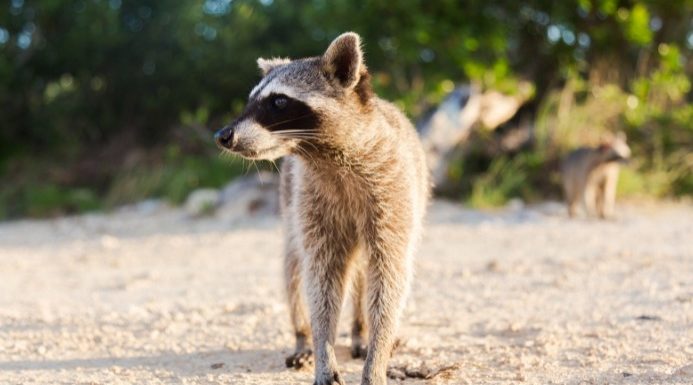
Raccoons, opossums, and skunks are scavengers in both urban and nonurban settings. They are notorious for spilling garbage-can contents onto lawns and back alleys.
They not only pose a sanitation problem but also can be disease vectors for rabies and can be threatening to household pets. If your dog or cat comes home smelling rancid or doesn’t come home at all, it may have had an altercation with a raccoon or skunk.
Female raccoons caring for their young can be particularly ferocious if they are cornered by another animal.
Table of Contents
Signs of a Raccoon, Opossum, or Skunk Problem
Although they can sometimes pose a rabies risk, raccoons, opossums, and skunks are primarily nuisance pests and pose a danger mainly to garbage cans and family pets.
Habitat Modification
Raccoons, opossums, and skunks have adapted to urban life by becoming primarily scavengers rather than hunting for their food as they used to. Depriving them of nesting sites and accessible water sources will cause them to look for more hospitable living areas.
- Brush cleanup: Remove brush, weeds, rockpiles, woodpiles, and other lawn debris to prevent animals from building nesting sites near your home.
- Chicken wire: Cover gaps beneath porches, houses, and other outdoor structures with chicken wire to eliminate hiding or nesting spots. Staple chicken wire to the perimeter of the structure with an industrial stapling gun, and bury it at least 6–12″ below the surface to ensure that a proper barrier is in place.
- Standing water: Eliminating sources of standing water from your property will make it less attractive to skunks and raccoons. Raccoons are especially fond of water because much of their natural diet consists of animals harvested from rivers, lakes, and streams. Denying them access to a water supply leaves these animals little choice but to go elsewhere.
Trapping
Trapping is the most sensible way to handle raccoons, opossums, or skunks that don’t respond to exclusionary or habitat modification tactics. Live trapping is your best bet in an urban setting.
- Choose one of the many varieties of live traps available at your local hardware store. Havahart® traps, which come with directions as well as suggestions for which baits to use for which animals, are very dependable.
- Set up the trap according to the manufacturer’s instructions. The following food baits work well: fresh fish for raccoons, bacon or cat food for skunks, and any kind of pet food for opossums.
- Once you’ve trapped an animal, you can take it to a remote area and release it unharmed. If you’ve trapped a skunk, bring two large, thick bedsheets out to the trap with you. Spread one out on the ground and hold the other in front of you as you approach the trap. Lay this sheet over the top of the trap, grasp the handle, and move the trap over the bedsheet on the ground. Wrap up the trap by folding the sheet on the ground over it. This will allow you to remove the skunk to a more remote area without being sprayed. Once you’re ready to release the skunk, find the end of the trap where the animal will be released and lift the cloth off. Open the trap and walk away quickly, but check to see that the skunk does in fact find its way out of the trap and into the woods.
If you’re not comfortable trapping live animals, find a wildlife management specialist in your area to do the job for you. (Many pest control companies do not handle larger wildlife such as raccoons, skunks, and opossums.)
Keeping Raccoons, Skunks, and Opossums Away
Sanitation and exclusion are your only options when it comes to preventing future problems with these animals.
- Lawn maintenance: Keep your lawn clean and manicured. Brush, leaves, and other piles of debris will be welcomed by any wildlife looking for a place to hide on your property.
- Compost piles: Keep compost heaps as far from your home as possible. Compost heaps that are added to on a regular basis may be frequented by wildlife that’s scavenging for scraps of fruits, fish, and other biodegradable foodstuffs.
- Trash and birdseed storage: If possible, lock garbage, recyclables, and birdseed in a shed until trash pickup day. If you don’t have a shed, make sure that you buy garbage bins that can be sealed and locked to prevent raccoons from opening them. Larger mammals have a capacity to solve puzzles—such as how to get the lid off your new trash bins.
- Motion-detecting lights: Motion-detecting lights are often effective at warding off raccoons and other wildlife. These creatures are nocturnal eaters and usually avoid brightly lit areas. It can be particularly effective to install motion-detecting lights near where you keep garbage and other refuse. If you’re renting, ask your landlord to have lights installed above the dumpsters.

